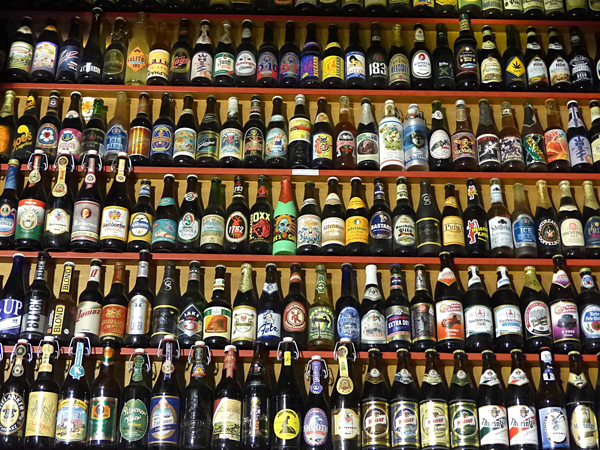The alcohol industry is facing its biggest hurdle as lawmakers in Europe are proposing putting a cancer risk label on all alcoholic beverages. This proposed law comes after multiple studies have found a link between alcohol consumption and cancer development in consumers.
The American Society of Clinical Oncology (ASCO) recently released a statement confirming the link between alcohol and cancer. The statement, published in the Journal of Clinical Oncology, comes after the organization reviewed previous studies on the issue.
“The link between increased alcohol consumption and cancer has been firmly established,” said Dr. Bruce Johnson, President of ASCO.
The review stated that about 3.5 percent of all cancer deaths in the US are caused by alcohol consumption. After looking over past research, ASCO also concluded that approximately 5.5 percent of all cancer cases and 5.8 percent of cancer-related deaths in 2012 were a result of alcohol consumption.
According to the American Cancer Society, alcohol can be linked to seven types of cancers: mouth, throat (pharynx), voice box (larynx), esophagus, liver, breast, colon and rectum. Alcohol can also increase the risks of developing pancreas and stomach cancer. All of these health risks are higher for those who consume alcohol regularly.
Although these cancer risks are higher in individuals who regularly consume alcohol, there is evidence that even moderate consumption of alcohol – one drink a day for women and two drinks a day for men – can increase cancer risks. However, if a person stops drinking for 20 years or more, they can reverse their risks to that of a non-drinker.
Though there is no direct explanation as to how alcohol may cause cancer in drinkers, certain tissues have been found to be negatively affected by liquor consumption. In the body, alcohol can act as an irritant and cause damage to the cells it encounters on its way through the digestive system. As these cells try to repair themselves, the potential for DNA damage, which can lead to cancer, increases.
A recent study by the MRC Laboratory of Molecular Biology in Cambridge, UK, found a direct link between acetaldehyde – a by-product that is produced after gut bacteria digest alcohol – and the resiliency of blood stem cells. The researchers fed mice a diluted solution of ethanol (found in alcohol) and analyzed its effect through DNA sequencing and chromosome analysis. What they found was that the blood stem cells (immature blood cells that can develop into white blood cells, platelets or red blood cells) in the blood and bone marrow in some of the mice had altered DNA results. These altered blood stem cells were found to have permanently damaged or broken DNA sequences which can result in the development of cancer.
The study also found that individuals who do not produce enough aldehyde dehydrogenases (ALDHs) – digestive and protective enzymes that are the first defence against alcohol damage – have a higher chance of developing certain cancers. It has been noted that many people of East Asian decent do not produce as much ALDH as others, meaning their risk of alcohol-related DNA damage is up to four times higher.
Such studies have led major lawmakers to look for ways to warn the public about alcohol-related cancer risks. The Royal Society For Public Health (RSPH) in the UK recently released a report titled “Labelling The Point” which proposes three key labels that should be placed on alcohol bottles: a mandatory warning linking to cancer development, a drink and drive warning on the front of the label and calorie content per serving. With 90 percent of Britons unaware of the connection between cancer and alcohol consumption, the RSPH hopes that these labelling techniques can deter them from regular consumption.
Major players in the alcohol industry have been opposing these propositions in order to maintain product sales. According to John Timothy from the alcohol industry standards body, the Portman Group, consumers do not appreciate “cluttered labels.”
“The study shows that 86 percent of consumers only look at labels for factual information and branding with 80 percent saying they would like to see less cluttered labels,” he said in a BBC interview.
In opposition to the Portman Group’s stance, Professor Sir Ian Gilmore said, “The decision last year by the Portman Group to weaken their recommendations on what should appear on alcohol labels clearly showed that alcohol producers wish to withhold information on alcohol and health from the public.”
Whether or not this labelling proposition finds success, the media coverage on this issue is assisting in public awareness.
“Having a drink with friends or family is something many of us enjoy. However, the potential health consequences of alcohol consumption are more serious than many people realise. If and when people choose to drink, they have the right to do so with full knowledge of both what their drink contains and the effects it could have. Consumer health information and warnings are now mandatory and readily available on most products from tobacco to food and soft drinks, but alcohol continues to lag behind. If we are to raise awareness and reduce alcohol harm, this must change,” said Shirley Cramer CBE, Chief Executive of RSPH.












Join or login to leave a comment
JOIN LOGIN